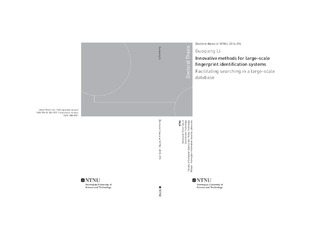| dc.description.abstract | Fingerprint recognition has gained wide acceptance and great popularity after the fingerprint recognition based applications have been adopted in diverse scenarios, such as forensics area (mainly by law enforcement agencies), access control products, financial transaction systems and mobile devices, etc. However, new challenges also emerge along with the extensive deployment of these systems. During the recognition process, a shorter response time is always desirable when an individual needs to be identified in a system with a database consisting of millions of fingerprints. In some systems, the database’s size is continuously growing. Meanwhile, gathering these millions of fingerprints in the database would be a high value target for the adversaries. With the hardware improvement in new products(such as the smartphone), it is also possible to incorporate fingerprint recognition into these new products in a user-friendly and low-cost manner, and further use for establishing the identity of an individual. These challenges and possibilities motivated us to investigate innovative methods which would benefit large-scale fingerprint identification systems in terms of accuracy, efficiency and security.
The performance of a large-scale fingerprint identification system can be affected in a number of aspects involved in the whole recognition process whose components generally consist of data acquisition, sample pre-processing, template creation, feature extraction, comparison algorithm and data storage. It is difficult to investigate all the research aspects involved in these components in one dissertation. We chose to work on several research aspects that we consider are either rarely studied or crucial for a large-scale fingerprint identification system.
The performance of the fingerprint identification system is sensitive to the sample quality, hence the first research aspect that we studied is to assess the quality of fingerprint samples taken from a smartphone’s camera. The smartphone has become as a part of our daily lives. Most smartphones contain a high resolution camera, network connectivity, powerful processor and large memory. These advanced hardware make a smartphone possible to act as a fingerprint sensor without adding extra resources. However, the quality of samples captured by such general-purposed cameras under an uncontrolled environment is unstable due to defocusing, poor illumination, or camera motion during the data acquisition process. In this dissertation, a quality assessment approach is designed to qualify the fingerprint samples taken from the smartphones’ cameras. In a practical scenario, a re-capturing action will be activated in order to obtain a good quality sample when the quality of a captured sample is considered poor by the proposed approach. In the end, a higher quality sample can contribute to the system recognition accuracy.
In order to accurately and efficiently establish the identity of an individual in largescale fingerprint identification systems, fingerprint indexing algorithm plays a crucial role in these systems. The second research aspect that we worked on is fingerprint indexing whose purpose is to output a short list of candidate identities which will be further used by a verification algorithm or even a human expert for manual verification. There are two research topics involved in a fingerprint indexing algorithm: (1) extract features which are suitable for building index space; (2) build the index space and retrieve candidate identities. In this work, three feature extraction methods are developed based on the fingerprint template, and different index space creation methods are explored to build the index space and to retrieve candidates.
According to a law ‘EU General Data Protection Regulation’ published in 2016, biometric data is recognized as sensitive data which requires protection. Thus the security is important for the biometric system. The third research aspect in this dissertation is how to protect the user’s fingerprint data. We studied this aspect by developing two approaches. The first one is a fingerprint template protection approach based on Bloomfilters. We investigated applying Bloom filters on fingerprint data, while Bloom filters have been successfully used to protect face data and iris data. The experimental results proofed the feasibility of this attempt. The second one is that we designed a fingerprint indexing algorithm in the encrypted domain. The proposed approach extracts the binary features and builds index space by using encrypted minutia information, thus no plain fingerprint data needs to be stored in the database. The security of the proposed approach is enhanced by a standard encryption algorithm. | nb_NO |
